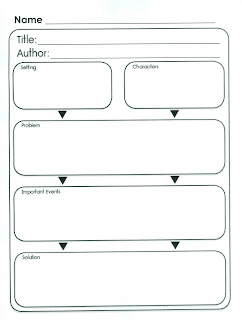Keep in mind
that there are many, many authors who write without outlining first. They have
an idea or a main character and just start writing. There is no wrong way to
write a story. I taught writing to fourth graders and always had them use a
Story Planner before writing so that I could see their plot before they spent a
lot of time writing out the story. I like thinking about where the story needs
to get to (the exciting part) so that I could help my students write a story
that gets there. I do a very brief plan for picture books and slightly more
detailed outline for chapter books. This is how I do it:
Picture Books
Students in first grade learn about
Story Mapping. This is an exercise in breaking down a book into pieces to help
with comprehension of the story. Students
learn that a story needs to have a beginning, middle, and an ending. Here are
some examples of Story Mapping Worksheets from a first grade class:
Since kids have to think about what
they read in this way, I use a similar approach to write picture book
manuscripts. I often think of a character first since I love character driven
stories so I jot down a few notes on the following things:
Characters
Setting
Problem
Important Events – Think in 3s. The
mc’s first attempt to solve his/her problem doesn’t work and leads to the
second attempt which doesn’t work and leads to a third attempt which either
solves the problem or creates a new problem. The thing about working in 3s is
that they have to make sense together and preferably are connected rather than
3 random ideas that simply don’t work. There are, of course, exceptions to
every rule (and this isn’t a rule, just something I have noticed in the
hundreds of books I have read).
Solution
I also like
to explain the plot this way: Main Character __________
wants to__________but can’t because __________ so __________.
Chapter
Books and Early Mid Grade Novels
Taking the
information I gathered in my chapter book and mid grade novel research (posted
in a previous blog), I begin writing this way:
Main Character
Age
What makes this MC different?
Problem
Solution
Outline of Chapters:
 I plan for
10 chapters but it can be as few as 3 and as many as 50 for a chapter book. I
have read that the “sweet spot” for word count is 6,000-10,000 words for
chapter books.
I plan for
10 chapters but it can be as few as 3 and as many as 50 for a chapter book. I
have read that the “sweet spot” for word count is 6,000-10,000 words for
chapter books.
At the
beginning, you need to show the reader (show don’t tell as often as possible) who
is MC is, how old, what the setting is and what the problem or goal is?
After this
is shown, let the reader know who or what is getting in the way of the MC
solving his/her problem or reaching that goal.
Here come
the attempts to solve the problem. Usually, the first and second attempts don’t
work because something gets in the way. The first attempt leads to the second
attempt which leads to either a new problem or the third attempt.
What is the
new problem? Will solving it get the solution to the first problem or create a
way that the MC can solve the first problem? If not, then take it out. There is
no room for bird walking in picture books or chapter books.
Show how
your MC makes a third attempt to solve the problem or reach the goal.
Solving the
problem/conflict/reaching the goal now means what? What was the point? What was
the point of getting there? Show the reader.
By now, you
should be at chapter 10 or near the end of your story . Wrap it up – Now that the problem is solved,
what new problem is created?
Now go write…




Thank you for this helpful post!
ReplyDeleteReally helpful post! Thanks for putting it together. I need to be more organized with my writing habits.
ReplyDeleteA very useful post! Thanks for sharing. Now I just have to sit down and start writing. (I've been putting it off.)
ReplyDeleteThis is helpful!
ReplyDeleteThis is wonderful! Thank you, Alison!
ReplyDeleteThese are great tools for setting up your story. Thanks so much Alison :)
ReplyDeletethanks for such helpful suggestions!
ReplyDeleteYou Rock! Alison!!! Thank you so much for these tips and suggestions.
ReplyDeleteAlison,
ReplyDeleteThanks so much...I've been head banging for a few weeks, trying to get over the "hump" with a few chapters. I know where the story ends, but got stuck for a bit. I was just starting to forge past and now this post! It's what I needed to JUMP over. Thank you!!!
This is excellent, Alison. I will print it out and have it near as I work on my chapter book project.
ReplyDeleteThank you!
This post is timely. I'm writing a picture book and a chapter book at the moment. So I am so glad I stopped by.
ReplyDeleteYes Mamm! This is excellent advice.
ReplyDeleteThanks for sharing the worksheets - they are great idea even for adults who are story writing!
ReplyDelete